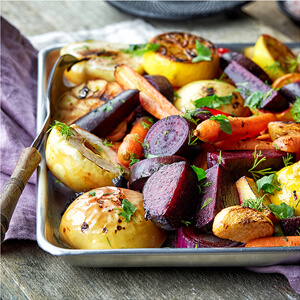Spices: Your secret to success

Need to spice up your meals? There’s no limit to the spices available at the grocery store. But how do you know which to choose? Here are four spices for you to discover—or rediscover.
Turmeric
Turmeric is one of the spices used in curries, an essential component of Indian cuisine. The spice gives food a little bit of heat and a bold yellowish colour.
Turmeric goes great with rice, vegetables, lamb, cinnamon, ginger, cardamom and cumin.
Benefits: Turmeric contains curcumin, which has anti-inflammatory and cancer-fighting properties.

Gourmet inspirations
Roasted root vegetables
Choose large parsnips and carrots of a similar or slightly smaller size. Scrub the parsnips and carrots but keep them whole. Coat the vegetables with oil and turmeric and place them on a baking sheet lined with parchment paper. Roast in the oven at 350°F for 20 to 25 minutes or until the vegetables are tender. Remove the vegetables, place them on a serving plate and garnish with fresh herbs. For a faster version of this recipe, slice the vegetables before coating and roast for approximately 10 minutes.
Chai tea latte
Warm some almond milk and mix in turmeric, ground ginger and ground cinnamon. Add a hint of honey and enjoy!
Cinnamon
Cinnamon is a unique spice with an intense, slightly sweet taste and fruity notes. Cinnamon sticks can be ground using a mortar and pestle, which releases all of the spice’s aromas.
Cinnamon goes perfectly with grilled chicken, meat stews, minced meat and fruit.
Benefits: Cinnamon improves digestion and helps lower levels of harmful cholesterol and blood sugar.

Gourmet inspirations
Cinnamon chicken
Prepare a marinade base using canola oil, a bit of white wine vinegar, a drizzle of maple syrup, salt and pepper. Add one cinnamon stick or half a teaspoon of ground cinnamon for 4 to 6 pieces of chicken. Marinate the chicken with the skin on for at least one hour. Next, remove the excess marinade and bake the chicken in the oven at 350°F, occasionally basting it with more of the marinade.
Grilled pineapple
Cut a pineapple into quarters and sprinkle them with ground cinnamon and a bit of brown sugar. Sear all sides on a cast iron grill pan, or better yet, grill on the barbecue. For a Brazilian touch, serve with grilled meats.

Sumac
Harvested from the fruit of a small shrub, sumac has a deep and beautiful red colour. Its flavour is both sweet and tangy and gives dishes a lemony taste. Sumac is a popular spice in Middle Eastern cuisine.
It’s perfect for dressings, beef, chicken, fish and hummus.
Benefits: Sumac is believed to have antioxidant properties.

Gourmet inspirations
Fattoush salad dressing
Add a bit of sumac and finely chopped fresh mint and thyme to an olive oil and lemon juice dressing. This dressing is a delicious choice for a Lebanese salad or to top a bed of tomatoes.
Zaatar
This spice mixture is very popular in Middle Eastern cuisine. To prepare homemade zaatar, mix two parts sumac to one part dried thyme (or oregano) in a mortar. Add grilled sesame seeds (same quantity as the thyme) and a bit of salt and ground pepper. Sprinkle the zaatar onto grilled pitas or serve it as a dip with olive oil.
Saffron
A few threads of saffron—the pistils of the crocus plant—are enough to give your dishes a splendid aroma. Saffron gives food a brilliant golden colour and can be steeped to fully bring out its slightly bitter flavour.
Saffron goes great with pasta, savoury rice dishes (risottos, paellas and pilafs), sweet rice dishes (rice pudding) and vegetables (bell peppers and eggplant).
Benefits: Saffron calms and improves digestion.

Gourmet inspirations
Rice pudding
Steep saffron in warm milk and use it instead of vanilla in your favourite rice pudding recipe. For an Oriental touch, adorn each serving with chopped pistachios.
Paella
Paella calls for a lot of care and attention—and a touch of saffron! Without a doubt, saffron is the key ingredient that elevates this rice dish with seafood, chicken and chorizo sausage. And as with anything prepared with love, this dish is best enjoyed shared.













